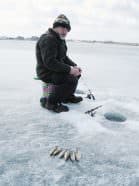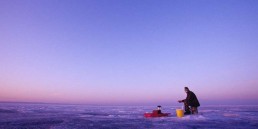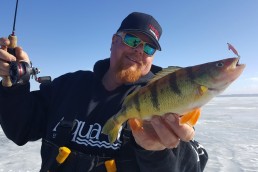Three Good Options for March Ice Fishing
SHARE THIS POST
Like ice fishing during any part of the season, a trip out to the lake in March requires a little thought beforehand. The last thing you want to do is simply drill some random holes in some convenient spot and hope some fish are there and willing to bite. In this article, I’ll pass along ideas about things that have worked for me during March. They should give you some possibilities for success in your area.
Weed flat pikes and walleyes
Some of the larger pikes and walleyes found in your area will be caught in relatively shallow water within vast beds of vegetation during March. The truth is, they have probably been there all winter, but most anglers head out to deeper water as soon as the ice is safe and stay out there all season. To find fishable spots, use a map and look for massive flats with heavy weed cover and depths of four to ten feet. The bigger these weedbeds are the better.
The easiest way to work the flats is to select a snow covered section that shows little evidence of foot or vehicle traffic. For example, a few snowmobile tracks across the flat are fine. Signs of heavy foot traffic, truck tracks crossing everywhere, or dozens of holes drilled into the area means lower potential.

The most successful method I have seen in this situation is to set out a series of tip-ups with quick-strike rigs and baited with small suckers or large golden shiners. With three anglers, you may be able to set six to nine tip-ups, depending on local regulations. Try to find about six feet of water in spots where small openings exist within the vegetation. Spread your lines over a wide area. Larger fish hunt these flats, moving through the weeds looking for smaller baitfish.
Some anglers park their trucks at the mid-point of the spread and sit in the cab while watching their lines. Others set portable shanties and take turns monitoring the tip-ups. A thermos of hot coffee and a box of donuts help pass the time. Some anglers use binoculars to scan the array of rigs. I’ve seen plenty of 25-inch walleyes and 40-inch pikes taken this way. Move your rigs at two-hour intervals to get to new spots.
River mouth drop-offs
This can be a real hotspot at late ice, but safety is the first consideration. I try to find the spot where an inflowing river drops into an adjacent basin area. In other words, the nearest deep water off the river mouth. Always remember that rivers can be among the first places to break up and create unsafe ice conditions. You may have to try drop-offs leading toward the river mouth rather than the actual mouth itself.
Are you enjoying this post?
You can be among the first to get the latest info on where to go, what to use and how to use it!
The targets here will be large walleyes along with bonus perch, whitefish, pikes, and trout in some cases. You will need to use two separate rods in most cases, to get the true potential these spots offer. A back or tail hooked 4- to 6-inch shiner minnow on a walleye rod sitting in a holder or on a bucket will catch walleyes. Keep the bait about four feet off bottom. On a second rod, run a size 2 or 3 Swedish Pimple lure with a small treble hook dressed with four to six “spikes” (maggots) or a wiggler with a couple spikes as well. This rig is for perch and if one steals your wiggler, the spikes will still be there to tempt another bite.
Work this perch lure from 6 inches to 3 feet off bottom by very lightly shaking the rod tip to make the lure “shimmy” and dance in place. Occasionally, drop the lure flat to bottom to stir up some silt, which can be a good attractor for perch.
Deep basin perch
On some of the lakes I fish, big perch are found in 30 to 40 feet of water just after the ice goes out, in deeper main basin areas of the lake. It seems to me that since they are found deep just after the ice disappears, they must have been there all along or moving toward those spots at late ice. Either way, you need a fast way to find biting fish.
As always, safety first. You should be leery of driving a truck out to deep-water spots at this time of year. ATVs, snowmobiles, or hiking out on foot may be better. Take a look out to deep basin spots. Are there other anglers out there? Are they using snow machines? Try to get an idea about ice conditions before heading out.
Once there, use rigs that help you get some bait down into deep-water spots quickly. A two-hook perch rig weighted with a 1/4-ounce bell sinker is a standard approach. The Swedish Pimple lures I mentioned with get deep quickly. Common perch baits like small shiner or fat head minnows, spikes, wax worms, or wigglers can all work. When two anglers are fishing, use different approaches to see if one is better than the other.
One of these three methods for catching late-ice fish should provide you with some good results. You can always try the shallower weed flats in the morning, then switch to basin perch in the afternoon. Be ready to switch methods if things are slow. Carry gear for both tactics so you are not skunked if your first plan does not work well. I guarantee that the fish are out there somewhere. The three locations I mentioned in this article have all given me great catches over the years. They can do the same for you.
MWO
SHARE THIS POST
You may also like...
Did you enjoy this post?
You can be among the first to get the latest info on where to go, what to use and how to use it!
Ray Hansen
MidWest Outdoors works with more than 200 outdoor experts each year, who contribute articles based on their areas of expertise. MidWest Outdoors magazine offers more fishing and hunting articles than any other publication!


